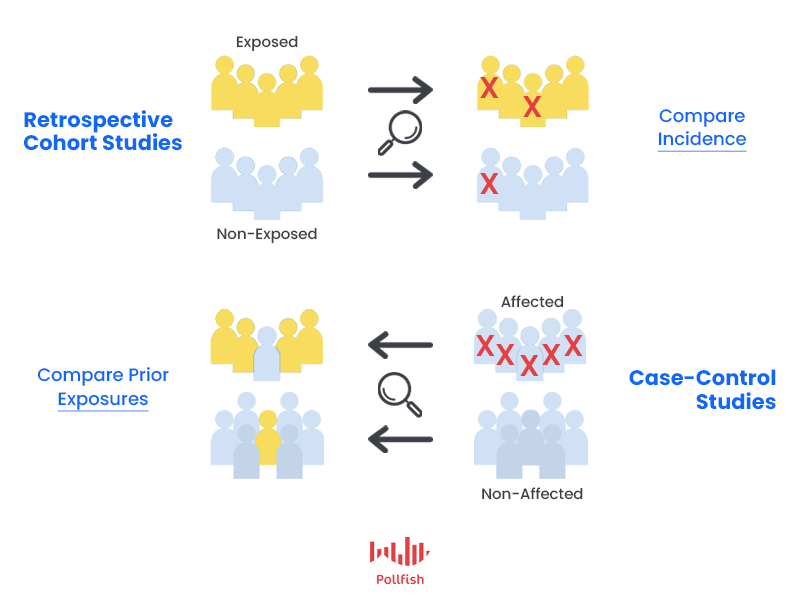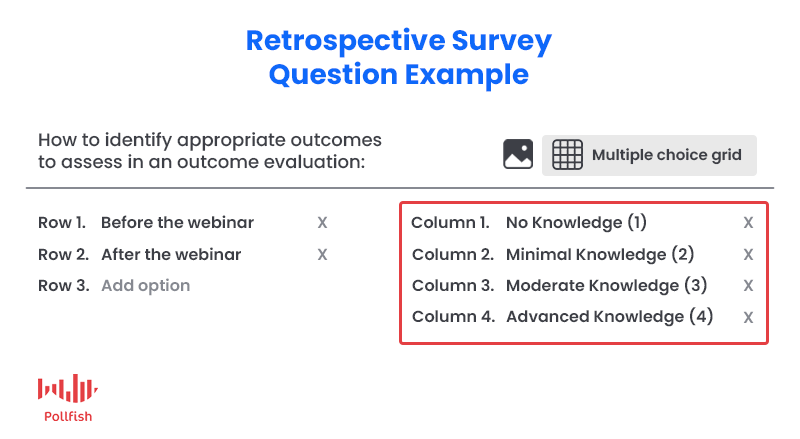Diving Into Retrospective Surveys

While most survey research involves looking into the here and now, there is one type of study that does quite the opposite. Retrospective surveys entail examining past events to see how they relate to outcomes (a study of interest) discovered at the beginning of a study.
Used in retrospective research, these surveys unlock many valuable insights that businesses can use to strengthen their marketing efforts and to better understand their target market.
That is because this study is not limited to medicine and psychology. This article will take a dive into retrospective studies and their accompanying surveys to make their purpose lucid in the business world.
Defining Retrospective Surveys
To put it in simple terms, in a retrospective study, researchers gather data on occurrences that have already happened. This places a retrospective study in opposition to a prospective study, in which researchers choose a survey panel or survey respondents from an online survey tool and follow the subjects over a period of time.
Also called historical research, a retrospective study inspects the historical data of a group of people. It falls under cohort studies, which are observational studies that determine how often a phenomenon occurs within a targeted population.
The purpose of a retrospective study is to discover how certain events and mindsets have unfolded or how they developed. It also looks at links and causes between studied events or phenomena. In the case of business, consider the following example:
A group of customers does not wish to make any online purchases. Their aversion comes in spite of the fact that they have internet access and a tendency to frequent the online space. A retrospective study would therefore inspect past events to learn about the factors that contributed to the consumers’ reluctance to shop online.
In this, the study and therefore the retrospective surveys, seek to find the links between experiences and unwillingness to shop online. They would also uncover when these phenomena began.
The Two Types of Retrospective Studies
There are two main types of retrospective surveys. They can be used in tandem as part of the broader retrospective study.

- Retrospective cohort study: This kind of study would seek to compare the risk of developing a certain outcome to some already known exposure factors. In retrospective cohort studies, the exposure and outcomes have already occurred. The studies are conducted on research already in existence. The exposures are defined before looking at the outcome data to see if exposure to a factor is associated with a significant disparity in the outcome development rate.
- Case-control study: This seeks to determine the possible exposure factors after a known incidence. Most case-control studies are retrospective, but some can be prospective. They define two groups at the onset of the study. These include both the one with the outcome and one without the outcome. They look to the past to find if there is a statistically crucial difference in the exposure rates of a risk factor between the two groups.
Using Retrospective Surveys with Cross-Sectional & Longitudinal Surveys
Retrospective surveys are not standalone surveys; they are usually conducted as part of a larger cross-sectional or longitudinal study.
In a cross-sectional study, research is gathered to find prevalence, which is the number of cases in a studied group at a specific point in time. Although cross-sectional and retrospective studies form their own survey methods, they share some common ground. This is mainly due to surveys, in that a retrospective survey, like a cross-sectional survey, can be conducted just once to find historical information.
Retrospective studies can be used with longitudinal studies, which study trajectories and changes over a period of time. Called retrospective longitudinal studies, this kind of research studies a sampling pool over a period of time — the time period involves data that was previously collected. As such, no data from the present and onwards is collected, as it is in longitudinal studies.
Examples of Retrospective Surveys

The following includes a few examples of retrospective studies. Surveys can be applied to all cases as part of the research process.
- A group of investigators study the records of factory workers from two decades ago. Their studies include retrospective surveys that question these workers’ health, well-being and exposure to a certain radiation, including its source of emanation. This would unearth whether there is a link between exposure to the radiation and certain health detriments.
- A researcher who wishes to learn about the origins of stomach cancer will interview a cohort of people who already have the disease. The study will involve asking the group about their medical history, lifestyle choices, family health history and habits to find the causes of the disease. The people with certain lifestyles may be compared with those of contrasting ones.
- A business owner seeks to discover why a segment of their target market is only interested in one offering of the company. This segment may be filled with loyal customers who predominantly shop from this business. As such, the business owner can conduct an investigation into past shopping experiences, purchases, habits, diversions and interests of the target subjects in the study. The business owner can then use those findings to see which and if any changes in certain aspects of life have contributed to this disinterest of offerings and if it can be changed.
The Pros and Cons of Retrospective Studies
Retrospective studies are useful for finding the what, when, where and how. They are thus used to find causal relationships between variables as well. Aside from their utility, these studies, along with their respective surveys have some drawbacks
The Pros
- These studies offer many insights: surveillance, evaluation, causation and impact of different variables within subjects.
- Looking at factors before the onset of a disease/occurrence can help assess the effects of rare or unusual factors, as researchers can identify a number of subjects who have them.
- These surveys can help determine if prospective studies are necessary to later carry out.
- They are among the fastest studies to conduct, along with cross-sectional studies.
- They are inexpensive, especially when compared to long-term longitudinal studies.
- Traditionally used in medicine and psychology, they also offer a creative way to understand the mindset and behaviors of consumers.
- There is no risk of loss of follow-up.
The Cons
- They are prone to recall bias, an incorrect remembrance which skews the accuracy of the study’s results.
- They are prone to misclassification bias, a systematic error that can crop up when a subject is assigned to a wrong category of identification.
- There is less evidence than that which exists from prospective studies.
- Since controls are usually recruited via convenience sampling, they don’t represent the general population.
- Time-related relationships may be difficult to evaluate.
The Utilitarian Nature of Retrospective Surveys
Although they are fast and relatively inexpensive, these studies can be difficult to conduct for a number of reasons. But their disadvantages shouldn’t sway you from charting these market research waters.
That is because you can avoid errors with surveys. Online surveys in particular grant you fast access to the behaviors and minds of your target market or subject of interest. For example, to weed out misclassification, you can conduct further surveys into your target market segments to better understand which kind of respondents fall under which categories.
All in all, you can take part in this kind of research due to the ever-utilitarian nature of online surveys.
Frequently asked questions
What is a retrospective survey?
In contrast to survey research that examines events in the present, retrospective surveys are conducted to examine events or occurrences that happened in the past.
What are some disadvantages of retrospective studies?
Some of the problems with retrospective studies are that they are subject to recall bias, prone to misclassification bias, may suffer from inaccuracies due to sampling bias, and don’t always provide sufficient evidence to draw strong conclusions.
What other terms are used to describe retrospective studies?
Retrospective studies may also be referred to as historical research. Retrospective studies are a type of cohort study, which is used to determine how often a phenomenon occurs within the studied population.
What is the purpose of a retrospective study?
A retrospective study is conducted to understand how and why certain events, feelings, attitudes, or behaviors have developed.
What are some advantages of retrospective studies?
Retrospective studies are able to examine a wide variety of variables, understand factors that occurred before an event or onset of a phenomenon, and offer an interesting way to understand the feelings and attitudes of the studied population. They are also fast, inexpensive, and relatively easy to conduct.
What are some disadvantages of retrospective studies?
Some of the problems with retrospective studies are that they are subject to recall bias, prone to misclassification bias, may suffer from inaccuracies due to sampling bias, and don’t always provide sufficient evidence to draw strong conclusions.
Pollfish Marketing Team
Ready to Try Pollfish?
Create your survey with AI, target high-quality respondents starting at $0.95 per complete, and start getting results in just minutes in real-time. From running a simple product concept survey to managing a constant stream of trackers for dozens of clients in dozens of countries, we’ve got you.
